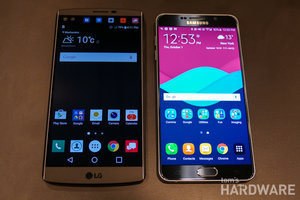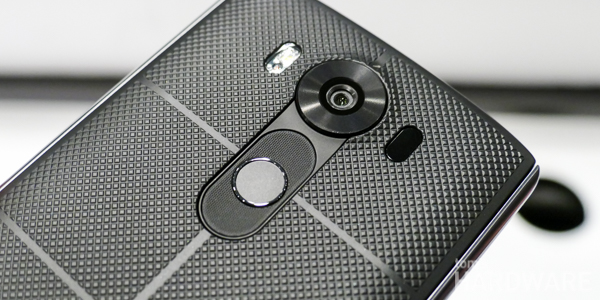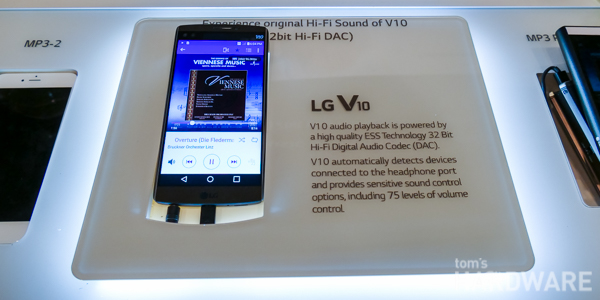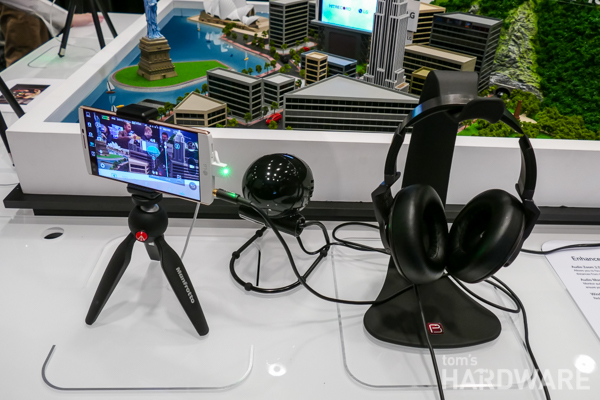The LG V10 Smartphone: A Metal Mobile Video Shooting Powerhouse (Hands On)

On Thursday, LG announced its latest smartphone, the 5.7-inch LG V10. This new flagship is part of a new V-series of phones from LG and features some unique innovations such as a secondary display, stainless steel construction and a manual video mode. All of this is on top of continuing its core features such as a removable battery and microSD slot.
We were at the New York City launch event and got to spend some time the V10, so check out our thoughts below.

Specifications
| SoC | Qualcomm Snapdragon 808 64-bit Processor (2 x Cortex-A57 and 4 x Cortex-A53) with X10 LTE |
|---|---|
| Display | Primary: 5.7-inch Quad HD IPS Quantum Display (2560 x 1440, 513ppi)Secondary: 2.1-inch IPS Quantum Display (160 x 1040, 513 ppi) |
| Memory | 64 GB eMMC ROM, 4 GB LPDDR3 RAM / microSD slot (up to 2 TB) |
| Camera | Rear: 16MP with f1.8 aperture & 1/2.6" Sony IMX234 Exmor RS image sensor / OIS 2.0 / LaserAF / Color Spectrum Sensor / Manual Mode / Video Manual ModeFront: 5MP dual lens (80-degree Standard Angle / 120-degree Wide Angle) |
| Battery | 3,000 mAh (removable) |
| Operating System | Android 5.1.1 Lollipop |
| Size & Weight | 159.6 x 79.3 x 8.6 mm (6.28 x 3.12 x 0.34 in), 192g (6.77 oz) |
| Network | LTE-A Cat. 6 |
| Connectivity | Wi-Fi 802.11 a, b, g, n, ac / Bluetooth 4.1LE / NFC / USB 2.0 |
| Materials | Stainless Steel, Dura Skin plastic |
| Colors | Space Black, Luxe White, Modern Beige, Ocean Blue, Opal Blue |
| Carriers | AT&T, T-Mobile and Verizon |
| Pricing | TBA |
Hands-On Video
Stainless Steel: Premium and Durable
LG has finally moved to metal for the construction of one of its phones. Although it previously made some older dumbphones out of metal, it hasn’t used this material in any of its smartphones. However, unlike some OEMs who incorporate metal for the sake of metal into their designs, LG has really thought about what using it means for a phone.

Metal doesn't just have to be about looks; it can add to the durability of a device, too, but only if you use the right material. Although aluminum looks great, in many ways it can be less durable than plastic because it doesn't react well to shocks and impacts. It either dents or bends and transfers the force to other parts of the phone, making the damage worse.

Stainless steel, like the 316L type LG is using (the same used on many high-end watches), is much stronger, so it won't easily dent or bend. LG has also smartly combined this steel "Dura Guard" frame with impact-absorbing plastic, allowing the V10 to be certified as "MIL-STD-810G Transit Drop Compliant." At the event, LG had a video playing showing the V10 being repeatedly dropped, and it held up very well.
It is interesting to note that in many of the drops, the removable back popped off, and after discussing this with some colleagues, we theorized that this feature helps even further with a phone's durability. Some of the impact force is transferred to the back of the phone, and when it comes off, this force is taken away from the phone, reducing the damage it could do.
Color And Design

When we saw the first pictures of the V10, we weren't sure what to make of the textured back. Although we still aren't too enamored with the lines that divide the back into a grid, in person, the V10 looks a lot nicer. The steel sides add a touch of class, and the back looks great and also has a ton of grip with its soft touch scratch-resistant "Dura Skin" coating. The top and bottom of the phone seem to have the same finish, too.
Get Tom's Hardware's best news and in-depth reviews, straight to your inbox.
As for color options, the V10 comes in black, white, beige, light (ocean) blue and dark (opal) blue. At the event, though, they only had the black, white and light blue models on display. We're not sure if this is a sign of which colors will be available in the U.S., or just that the others weren't ready to show yet.


At a minimum, you can expect to see the black and white models come to U.S. carriers. The white model is also notable for having a rose-gold (the smartphone color du jour) finish applied to the steel sides and camera surround. It's not our cup of tea, but it's sure to appeal to some. We do hope that LG does offer some optional different color backs, as they do with the leather back for the G4.
The Second Display
Out of all the features of the V10, its secondary display is probably the only one whose value we question. That's not to say that it isn't implemented well – it is, but if the phone didn’t have it, we wouldn't think any less of it. It also adds quite a bit of vertical height to the V10, making it a rather large phone. Yes, it is a 5.7-inch device, so one shouldn't expect it to be small, but other large-screen devices like the Moto X Style and Galaxy Note5 have managed to squeeze the same size screen into much smaller frames. For example, check out the side-by-side of the V10 and Note5 below.


Whether we see the value or not, the second screen does do some neat tricks. Of course, by default it acts as a ticker-tape style information bar above the main screen, which can display app shortcuts, contact shortcuts, notifications, music controls and more. In addition, though, when the V10 is off, it can be set to "always on" to show the date, time and weather, and also four customizable shortcuts; shown below are ringer, Wi-Fi, flashlight and camera shortcuts. Perhaps our favorite use of this display is to be a persistent panel for the camera mode buttons, making them easier to access when taking pictures or video.


Having another display above the main panel, especially one that is also IPS, not a more power-efficient AMOLED screen, means there will be some impact to battery life. LG claims that it only uses up around 5 percent more battery. If you're of the mind that even that is too much, the secondary screen can be turned off permanently in the settings.
Internal Specs and Software: (Almost) More Of The Same
Internally, the V10 isn't substantially different than its older, smaller brother, the 5.5-inch LG G4 (which you can see in the size comparison with the V10 below). LG kept using the SnapDragon 808 SoC to avoid having to deal with the power consumption and heat issues of Qualcomm's flagship 810 SoC. Now that the 810 has been around for a while and other OEMs have learned how to avoid its problems and get the most out of the SoC, usually by underclocking it, we wish that perhaps LG had revisited it, too.

Although the 808 is no slouch, it is hampered by its noticeably slower GPU and lack of support for things like DDR4 memory and the H.265 High Efficiency Video Coding (HVEC) standard. H.265 encoding would make the V10's 4K video file sizes a lot smaller. Still, from our time with the G4, the 808 can still deliver excellent performance, and in the little time we used the V10, we didn't experience any slowdowns or performance issues.
The V10 does best the G4 by having 4 GB of RAM and more default storage (64 GB vs. 32 GB). The single speaker has been moved to the bottom to fire downward, improving over the G4's speakers that face to the rear and is easily muffled. Unfortunately, this placement can also be blocked by your hand, especially when holding the phone in a landscape orientation.
The V10 does now have a fingerprint reader, one of the things I missed most after I switched from the Note 4 to the G4. Even if you aren't planning on using it for mobile payments with Android Pay, it makes logging into the phone and using password management apps like LastPass a lot faster. The V10 uses a circular touch-style reader (similar to the LG Nexus 5X) under the power button, which is located on the back, along with the volume controls, in LG's trademark way, below the camera.

The LG UI on the V10 doesn't look to have changed in any way from the G4's (well, other than the fact that the info can also be shown on the second screen). This time around, it is running over Android 5.1.1. LG's current UI is fairly attractive, and it adheres quite well to Google's Material design language, but it still feels a little rough around the edges when compared to stock Android or the latest iteration of Samsung's TouchWiz.
We also worry about how well LG will keep the V10 updated. This phone will be yet another new device that is going to ship with an older version of Android other than the current one Google offers. Let's hope an update to Android Marshmallow (6.0) isn't too far off.
The Last American Hero
LG is the last big Android OEM to still offer two longtime mainstays of Android phone design: a removable battery and microSD storage expansion. Unfortunately, the battery isn't any bigger than the G4's, still at 3,000 mAh, so the bigger screen and second screen probably give the V10 slightly less runtime. The microSD slot can take up to 2 TB cards, although at the moment, the largest readily-available one is a 200 GB card from SanDisk that costs a whopping $200.

The V10 supports Qualcomm's Quick Charge 2.0, but it still has a microUSB (version 2.0) port. With many OEMs moving to USB Type-C now, it would have been nice if LG followed suit, too. Although wireless charging isn't supported out of the box, you'll be able to add it with optional backs (that support either the WPC Qi standard or the PMA standard).

Another area that LG has invested in with the V10 is its audio quality. At the launch event, it had the V10 connected to some high-end audio hardware to show off its audio output chops. We didn't get a chance to listen to the V10 playing music, but on paper, its ESS Technology Sabre 9018 32-bit Hi-Fi DAC and Sabre 9602C headphone amplifier means that the V10 should have some of the best audio output of any phone.
It's All About The (Video) Camera
If there is one feature of the V10 that stands out above all else, it is its vastly improved video capture mode. If the G4 was all about improving still capture performance, then the V10 would be all about video (which would explain the V). What hasn't changed is the actual camera hardware over the G4. The V10 still uses the Sony IMX234 Exmor RS image sensor, has an f/1.8 lens in front of it, and it has the same improved OIS 2.0, the laser autofocus, and the color spectrum sensor for more accurate white balance. That means you can expect identical still capture performance when compared to the G4.

What LG has done is to take all the great things about the G4's manual mode and applied them to the video side of the shop. When we looked at the G4, we thought it was odd that its video mode was so lacking, and now that the V10 is out, it's almost like this was a conscious decision, wink wink, nudge nudge.

We can comfortably say that the V10's manual video mode is the most powerful and fully-featured of any smartphone. Not only does it have the usual selection of manual shutter speed, focus, white balance, and exposure controls, but LG has also incorporated full manual control over the V10's audio capture when shooting video. You can not only see the audio levels, but also monitor them with headphones, and control the capture volume during shooting.
You can also change the capture balance, moving it from in front of the phone to behind the phone, utilizing the V10's three microphones. Audio capture when shooting video is something that is often neglected, even on dedicated cameras, so it is great to see LG paying so much attention to this.
Further, just as the audio levels can be adjusted while shooting, all the other manual controls can be changed while recording, so you can, for example, use the manual focus to pull focus and shift the viewers' attention. The V10 also now has Electronic Image Stabilization (EIS) that, although it reduces the capture image size by 20 percent, it does reduce the dreaded "jello" effect when shooting video while the phone is moving.

Finally, LG hasn't just focused on controlling capturing the video but has invested time in giving users the most comprehensive control over frame rates, resolutions and bit rates. The V10 can capture video in 720p, 1080p and 4K. You can also toggle between 16:9 and a more film-like 21:9 aspect ratio, and change the bit rates of each resolution from low to medium to high.
In 1080p, those rates are 10, 17 and 24 Mbps, and in 4K, they're 30, 48 and an outstanding 64 Mpbs (which will produce awesome-looking video…and also chew through the V10's storage like no tomorrow).
All in all, the V10's video mode blows the competition away, and it looks like this phone is the first that we (and I am sure many other professionals) would consider using to shoot "real" videos. Of course, this is all conjecture, and we'll have to test the V10's video mode first before we can claim it is the best, but we like what we see so far.
Another less important (at least to us) feature is the V10's dual front cameras. Instead of one wide front camera, the V10 has two 5MP camera that have different focal lengths -- one at 80 degrees, which is perfect for solo selfies, and one at 120 degrees for group shots. There is also a mode where you can set it to capture a picture will all three cameras, which if you ask us is a bit gimmicky, but we suppose may have some fans.


LG's New Flagship Smarty Improves On Its Predecessor
Although we think the G4 is a good phone, there are a few areas where we did find it a little lacking, and it looks like LG has addressed all of them with the V10. It's almost like this was its plan all along. The V10 is a premium device made from premium materials that hasn't given up on features that for many Android users are non-negotiable -- a removable battery and microSD slot.
When it came to adding the material that everyone seemed to be asking for, metal, LG carefully thought how to use it on the V10 to add more than just aesthetic value, and the choice of stainless steel over aluminum allows for a more durable device. It also has what looks to be one of the best all-round cameras of any phone, with excellent still and video performance.
We like that LG seems to get that even in the premium space, there isn't one size that fits all, and there is room for a phone that perhaps has some features that have more of a niche appeal. With the V10, the V standing for "Video," LG has created the ultimate (on paper) phone for content creators, which means it might not be for everyone, but it's the perfect phone for many.
The only concerns we have are that it is quite big for a 2015 phone, thanks to the secondary display that we could perhaps live without, and that its internal specs haven't been improved much from the G4's. Also, the 3,000 mAh battery might struggle to produce sufficient battery life with the V10's two screens.
The LG V10 is coming out in Korea next week, and in the U.S. soon, most likely late October or early November. No pricing has been announced, but it is sure to cost more than the G4 (though not by too much -- LG isn't Samsung or Apple), and it will be available on AT&T, T-Mobile and Verizon. (Sorry, Sprint customers.)
-
Chris Droste honestly, since i already have the G4, this doesn't light my heart aflame. if they bumped the battery to 3,400mAh or went to a Snapdragon 820, then we'd be talking. I will likely be waiting for them to move to a vastly better chip, though i don't really have any problems now.Reply -
rupertchuck Exactly my thoughts! I've got a G4 and I'm mostly happy with it, with my only complaint being the battery life.Reply -
Player911 Love my G4. However I cant see any reason to buy a G4 over this. This is basically a G4S (haha GAS). Thats my only complaint with LG is they have too many high end phone. While its nice to have fresh options, it does create a sour taste when you buy a flagship only to have the same company out do their flagship a few months later. IMO the G4 is the phone to beat these days.... so whats the rush?Reply